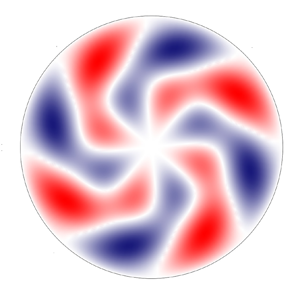Article contents
Growth of vortical disturbances entrained in the entrance region of a circular pipe
Published online by Cambridge University Press: 02 December 2021
Abstract

The development and growth of unsteady three-dimensional vortical disturbances entrained in the entry region of a circular pipe is investigated by asymptotic and numerical methods for Reynolds numbers between  $1000$ and
$1000$ and  $10\,000$, based on the pipe radius and the bulk velocity. Near the pipe mouth, composite asymptotic solutions describe the dynamics of the oncoming disturbances, revealing how these disturbances are altered by the viscous layer attached to the pipe wall. The perturbation velocity profiles near the pipe mouth are employed as rigorous initial conditions for the boundary-region equations, which describe the flow in the limit of low frequency and large Reynolds number. The disturbance flow is initially primarily present within the base-flow boundary layer in the form of streamwise-elongated vortical structures, i.e. the streamwise velocity component displays an intense algebraic growth, while the cross-flow velocity components decay. Farther downstream the disturbance flow occupies the whole pipe, although the base flow is mostly inviscid in the core. The transient growth and subsequent viscous decay are confined in the entrance region, i.e. where the base flow has not reached the fully developed Poiseuille profile. Increasing the Reynolds number and decreasing the frequency causes more intense perturbations, whereas small azimuthal wavelengths and radial characteristic length scales intensify the viscous dissipation of the disturbance. The azimuthal wavelength that causes the maximum growth is found. The velocity profiles are compared successfully with available experimental data and the theoretical results are helpful to interpret the only direct numerical dataset of a disturbed pipe-entry flow.
$10\,000$, based on the pipe radius and the bulk velocity. Near the pipe mouth, composite asymptotic solutions describe the dynamics of the oncoming disturbances, revealing how these disturbances are altered by the viscous layer attached to the pipe wall. The perturbation velocity profiles near the pipe mouth are employed as rigorous initial conditions for the boundary-region equations, which describe the flow in the limit of low frequency and large Reynolds number. The disturbance flow is initially primarily present within the base-flow boundary layer in the form of streamwise-elongated vortical structures, i.e. the streamwise velocity component displays an intense algebraic growth, while the cross-flow velocity components decay. Farther downstream the disturbance flow occupies the whole pipe, although the base flow is mostly inviscid in the core. The transient growth and subsequent viscous decay are confined in the entrance region, i.e. where the base flow has not reached the fully developed Poiseuille profile. Increasing the Reynolds number and decreasing the frequency causes more intense perturbations, whereas small azimuthal wavelengths and radial characteristic length scales intensify the viscous dissipation of the disturbance. The azimuthal wavelength that causes the maximum growth is found. The velocity profiles are compared successfully with available experimental data and the theoretical results are helpful to interpret the only direct numerical dataset of a disturbed pipe-entry flow.
- Type
- JFM Papers
- Information
- Copyright
- © The Author(s), 2021. Published by Cambridge University Press
References
REFERENCES
- 3
- Cited by



